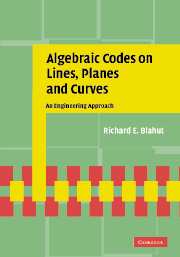Book contents
- Frontmatter
- Contents
- List of figures
- List of tables
- Preface
- Dedication
- 1 Sequences and the One-Dimensional Fourier Transform
- 2 The Fourier Transform and Cyclic Codes
- 3 The Many Decoding Algorithms for Reed–Solomon Codes
- 4 Within or Beyond the Packing Radius
- 5 Arrays and the Two-Dimensional Fourier Transform
- 6 The Fourier Transform and Bicyclic Codes
- 7 Arrays and the Algebra of Bivariate Polynomials
- 8 Computation of Minimal Bases
- 9 Curves, Surfaces, and Vector Spaces
- 10 Codes on Curves and Surfaces
- 11 Other Representations of Codes on Curves
- 12 The Many Decoding Algorithms for Codes on Curves
- Bibliography
- Index
11 - Other Representations of Codes on Curves
Published online by Cambridge University Press: 05 October 2009
- Frontmatter
- Contents
- List of figures
- List of tables
- Preface
- Dedication
- 1 Sequences and the One-Dimensional Fourier Transform
- 2 The Fourier Transform and Cyclic Codes
- 3 The Many Decoding Algorithms for Reed–Solomon Codes
- 4 Within or Beyond the Packing Radius
- 5 Arrays and the Two-Dimensional Fourier Transform
- 6 The Fourier Transform and Bicyclic Codes
- 7 Arrays and the Algebra of Bivariate Polynomials
- 8 Computation of Minimal Bases
- 9 Curves, Surfaces, and Vector Spaces
- 10 Codes on Curves and Surfaces
- 11 Other Representations of Codes on Curves
- 12 The Many Decoding Algorithms for Codes on Curves
- Bibliography
- Index
Summary
In contrast to the class of Reed–Solomon codes, which was introduced by engineers, the class of hermitian codes was introduced by mathematicians as an example of an important class of algebraic geometry codes. In this chapter, we shall reintroduce hermitian codes as they might have appeared had they been discovered by the engineering community. Some additional insights will be exposed by this alternative formulation. In particular, we will shift our emphasis from the notion of punctured codes on curves to the notion of shortened codes on curves. We then give constructions of hermitian codes as quasi-cyclic codes and as linear combinations of Reed–Solomon codes akin to the Turyn construction. Much of the structure of hermitian codes stands out quite clearly when a code is restricted to the bicyclic plane (or torus), thereby forming an epicyclic hermitian code. If one takes the view that the cyclic form is the more fundamental form of the Reed–Solomon code, then perhaps one should take the parallel view that the epicyclic form is the more fundamental form of the hermitian code. In particular, we shall see that, for the epicyclic form of an hermitian code, there is no difference between a punctured code and a shortened code. This is important because the punctured code is compatible with encoding and the shortened code is compatible with decoding. In Section 11.2, we shall provide a method for the direct construction of shortened epicyclic hermitian codes.
- Type
- Chapter
- Information
- Algebraic Codes on Lines, Planes, and CurvesAn Engineering Approach, pp. 453 - 483Publisher: Cambridge University PressPrint publication year: 2008



